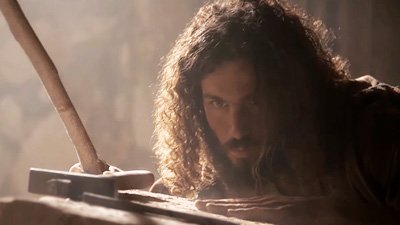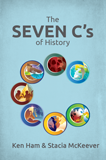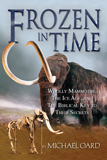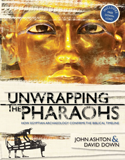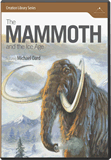10,000 B.C.
Can a film dated six thousand years before creation offer anything to Christians?
Its merits as a cinematic spectacle aside, Roland Emmerich’s 10,000 B.C. offers a good opportunity to take a look into what the world might have been like a few centuries after the dispersion at Babel.
The film, starring the young Steven Strait as tribesman D’Leh, has grand leanings that link together action and adventure with a love story. D’Leh’s mammoth-hunting tribe (the Yagahl), already down on its luck, is attacked by “four-legged demons” (a horde of horsemen) who capture most of the tribe, including D’Leh’s love interest, Evolet (Camilla Belle). D’Leh and a few others set out in pursuit, encountering new lands, new tribes, and, eventually, the new empire their enslaved tribesmen are now serving.
It has most of the makings of a wannabe epic, including a full-bodied orchestral score, a few dramatic warrior speeches, and computer-generated effects throughout. The film’s simple plot, with relatively little nuance and less than two hours to develop, along with bits of lowbrow humor, remind us that the film’s target audience is probably adolescents. Indeed, the theater I attended was filled with males of such age with their fathers, eager to watch the tribesman battle CGI mammoths along with plenty of sword and spear fights.
I was also on the lookout for any sort of evolutionary indoctrination the film might carry, especially given its date of six millennia before the date the Bible gives as the dawn of humanity. Would this film be just another opportunity for Darwinists to subtly inject their worldview through a Hollywood blockbuster?
Synopsis
The story opens with narrator Omar Sharif telling the story-in-brief of the Yagahl tribe, mammoth hunters whose prey is dwindling but who are still dependent on the beasts for every aspect of their livelihood. “Only time can teach us what is truth and what is legend,” the narrator tells us as we watch the story of one Yagahl warrior—soon revealed to be the protagonist’s father—departing on an unknown mission.
The first major scene is the arrival of Evolet, a bright-blue-eyed child who escaped from the same fate that will eventually befall the Yagahl. In a stale scene, the tribe’s shamanic “Old Mother” shakes and quakes while the face-painted tribesman hear her gloom-and-doom prophecy about “the last hunt” and the one who will both love Evolet and, in unoriginal serendipity, save the tribe from this evil-to-come. Close-up shots on a young boy watching from outside the tent make it clear that our protagonist is the young D’Leh.
The movie quickly makes it to the first and only mammoth-hunting scene, with all the dreadlocked tribesmen crawling through grasses and signaling to each other like a World War 2 infantry platoon. The scene is neither long enough nor treacherous enough to inspire a viewer’s heart rate, but nevertheless the CGI mammoths are lovely to watch and an exciting reminder that these creatures walked the earth not so long ago. Their resemblance to the Asian elephant—the key visual difference between them being the mammoths’ wool, of course—also reminds us that their kin walk the earth today.
Although we have no primary sources to detail how early man hunted, the film shows sophisticated techniques that may well have been used by Adam’s descendants and re-learned by tribes after Babel. The tribesmen force the mammoth herd to stampede, driving the mammoths through a rocky pass where a trap is waiting. As the last, slowest mammoth follows the herd into the pass, a large rope net flies up (hoisted on pulleys powered by dropped rocks) to trap it—natural selection, indeed! In this case, the trap doesn’t work perfectly, but the tribe’s quarry is eventually captured regardless.
Not long after come the prophesied four-legged demons, a small band of horsemen who kill a few tribesmen and capture the rest while D’Leh is camping in the hills nearby. He returns to find nearly everyone, including his beloved Evolet, marching away in shackles, but the wise old Tic’Tic (Cliff Curtis) keeps him from hastily chasing after, instead gathering a trio (and eventual foursome) to chase the demons over “the great mountains.”
The chase then begins and lasts for most of the movie. Although the pursuers catch up to their captured kinsmen early on, they fail to complete the rescue and the pursuit goes on—through jungles and wetlands, then on through the rugged desert. Along the way, we encounter other CGI beasts and fowl, including terror birds and a saber-toothed tiger.
The turning point is when the pursuers come in contact with a larger tribe, led by Nakudu (Joel Virgel), that was similarly attacked by the horsemen and whose tribesmen were also taken prisoner. This tribe, which lives in house-like dwellings in a small city and has an irrigated field, joins D’Leh and marches with him in pursuit of the horsemen. Other tribes join as they continue, and eventually D’Leh, along with Tic’Tic and Nakudu, lead their army through an arid, Sahara-like desert (a “sea” of sand, it’s called) to find where their friends have been taken: a massive construction project that looks strangely familiar—pyramids, the unfinished Sphinx, and other giant buildings.
The film’s conclusion was mostly predictable, with the army successfully leading a slave revolt, D’Leh rescuing Evolet, and so forth. There’s a bit more nuance and intrigue than that, but not much; the simplicity and predictability are the two most clear weaknesses of the film. Of course, that shouldn’t scare away younger audiences or those who simply want an easy-to-understand adventure, and simplicity of plot hasn’t kept previous epics from reaching box office heights.
In fact, although the point of this review is not to give an in-depth judgment of the film’s cinematic quality, I felt many of the reviews syndicated nationally so far have been unduly harsh on the movie. For example, the AP-syndicated Christy Lemire review, while accurate about most of the film’s weaknesses, seems to ignore the similarly shallow characters and simple storyline of other successful “feel-good” epics. There are certainly no twists or mysteries that require a second viewing, but the target audience probably won’t complain about such absences.
Issues
So what about evolutionary indoctrination? Can a creationist watch this film without cringing? Or does this film offer anything to the Christian viewer?
At the outset, I was bracing for the worst in terms of proto-human stupidity, references to ancient man, and anti-Bible cracks. But as the film began to unfold, the characters and scenes seemed more appropriate for a story that might be set in post-Babel days. Although the tribesmen were (obviously) less “civilized” in a modern sense, there was a clear social order, and the grammar of the language they spoke was also fully developed (though the vocabulary, at times, seemed jarringly rudimentary).
The tribe’s skin color, mid-brown and ambiguous “racially,” also fits well with our conception of what the people of the post-Eden and post-Babel world may have looked like shortly after the dispersion. The full gradient of skin colors is encountered as the film proceeds, with those of different skin colors intermingling without prejudice; whether it was this way after Babel is unknown, of course, but it is encouraging to see such relative racial ambiguity. In terms of language, we hear at least four or five that do not sound similar, from the Yagahl’s strangely accented but otherwise flawless English to the guttural speech of the raiding horsemen.
As for costumes and appearances, all the characters and peoples in the film seem to emphasize jewelry, from the bone-carved jewelry of the Yagahl to the more exotic jewelry of other tribes, culminating in the golden jewelry of the “almighty” (the pharaoh) and his servants in Egypt. We see a variety of clothing, from the hide-and-fur outfits of the Yagahl to the dyed-cloth robes of the Egyptian clerics. Again, this represents well what we know about the clothing of intelligent early man. And unlike the infamous One Million Years B.C., the women are not scantily clad; in fact, there is only one instance of a moderately revealing dress worn by Evolet at the end.
In terms of accuracy, one unsurprising inaccuracy was the well-groomed appearance of most of the main characters in spite of their dreadlocks. Apparently, the facial hair of the Yagahl tribesmen grows only in neat goatees, and apparently most of the main characters had time to shave regularly in-between scenes. Likewise, orthodontia was apparently common among most of the tribes the film portrays.
The mammoth hunting gives us not only a glimpse at what real mammoth hunts may have been like, but shows us how our ancestors may have hunted other large beasts, including dinosaurs. And the terror birds could easily be stand-ins for pterosaurs. The film reminds us that, aside from evolutionary interpretations of the fossil record, there’s no reason man could not have cohabited the earth with dinosaurs, just as we cohabit the earth today with large and dangerous animals. Man’s intelligence allowed him then, as now, to avoid, fight, or even hunt these creatures.
And although the transition from hunting to agriculture, as shown in the movie, comes straight from the evolutionary textbook, it’s fully compatible with the creationist worldview; though agriculture was known since Adam, it is likely that not all post-Babel tribes relied on agriculture; various nomadic tribes relied on hunting for sustenance even in the last millennium.
Not only does the film portray (whether knowingly or not) what post-Eden or post-Babel life may have been like; it also, presumably knowingly, references the plight of the slaves in Egypt. I naturally thought of Joseph while watching the slave traders march their Yagahl captives to the pyramids; the complex scaffoldings and large-scale simple machines shown in the construction of the pyramids were probably not far off from true history, along with the use of beasts (more wooly mammoths, in the film’s case) to pull large loads around the work sites. In addition, the slave drivers remind us of the reality of the Hebrew oppression in Egypt after Joseph.
Conclusion
Ultimately, is this film worth the time and money to see it for a Bible-believing Christian? And is it family friendly?
Let me deal with the second question first. In terms of appropriateness for families and youth, the film is rated PG-13 for sequences of intense action and violence (12A in the U.K., 14A/PG/G in various parts of Canada, and M in Australia / New Zealand). We definitely don’t recommend letting any pre-adolescents watch this on their own, for several reasons. First, the aforementioned action and violence, though mostly bloodless and conceptual, is nevertheless pervasive; more than one person is run through with a spear, and the slave revolt at the end doesn’t come without a price, though (again) there is relatively little blood and no gore. D’Leh must also cauterize a wound at one point. The height of conceptual violence (not carried out, thankfully for both D’Leh and the audience) is when the pharaoh requests that Evolet be torturously killed to force an end to the rebellion. She’s tied up, but that’s as far as it goes.
Second, the action scenes, with rapid camera shots, loud animal noises, and a few screams, may be too much for young viewers; the scene featuring the terror bird attack was so choppy as to be sloppy from a cinematographic standpoint, but it might unsettle children.
Third, although there is no overt sexuality in the film other than a few embraces and Evolet’s aforementioned low-cut dress, it will be clear to more mature audiences that Evolet is more than once threatened by lewd intentions.
Finally, the religion of the Yagahl, replete with the clairvoyant Old Mother and hints of ancestor worship, bears no similarity to monotheism, but it very well could have been the religion of a post-Babel tribe that had already replaced the faith of Noah with humanism.
That all said, the film, which is free of foul language, is mostly safe for adolescents and above who are prepared for an action-packed adventure framed over a simple storyline.
Now, is the film worth the time and money for a Bible-believing family? Only you and your family, of course, can decide what level of violence—conceptual or otherwise—you will tolerate on screen, and the action/adventure plot may simply not appeal to some families. And as we’ve said, the film is no cinematic masterpiece; it received only seven percent positive reviews (see Rotten Tomatoes) and audiences have not been in love with it (see Metacritic).
That said, if your imagination is up for it, the Bible-believer can easily imagine the story taking place a dozen generations after the dispersion at Babel, just as the pyramids were getting underway; the humans are portrayed as fully intelligent, and I saw no evolutionary dogma shining through (other than, for instance, the lack of dinosaurs, lack of mentions of the Flood or Babel, etc.). You could even use the film as a springboard to talk to your children about the ancient history from Babel through to Moses, and how most of mankind so quickly turned away (again) from the one true God. Plus, you can explain to them the timeline the Bible gives for the 7 C’s, and together the whole family can imagine what life was like around 1,000 B.C.—close to what we would suggest for the setting of the film.
10,000 B.C.’s selling points aren’t a brilliant story, Oscar-winning acting, or documentary accuracy; rather, it’s a mostly innocent action/adventure romp with great special effects and a (mostly) happy ending. If that’s okay with you, if your little viewers will be able to handle it, and if you love to imagine what life was like “B.C.,” 10,000 B.C. may be a great way to spend two hours and a terrific springboard to discussing the history given in Genesis and Exodus.
Recommended Resources

Answers in Genesis is an apologetics ministry, dedicated to helping Christians defend their faith and proclaim the good news of Jesus Christ.
- Customer Service 800.778.3390
- © 2024 Answers in Genesis


